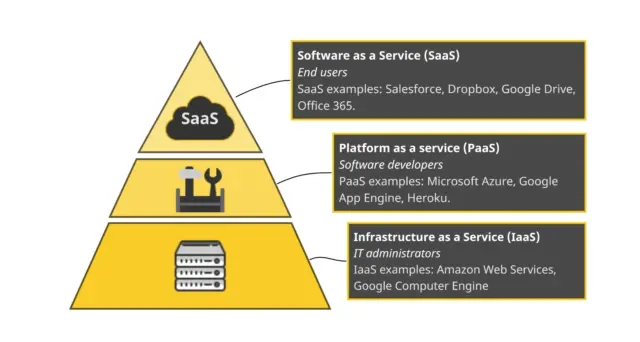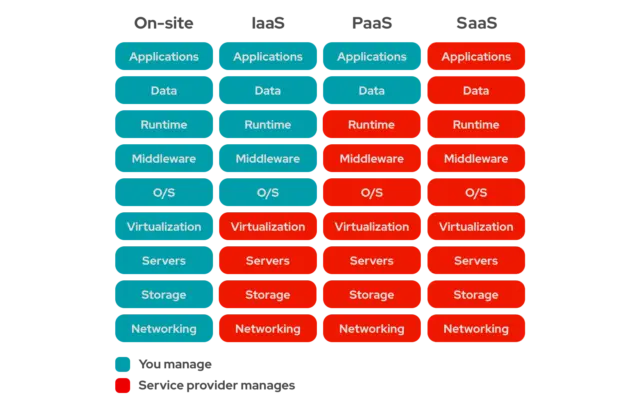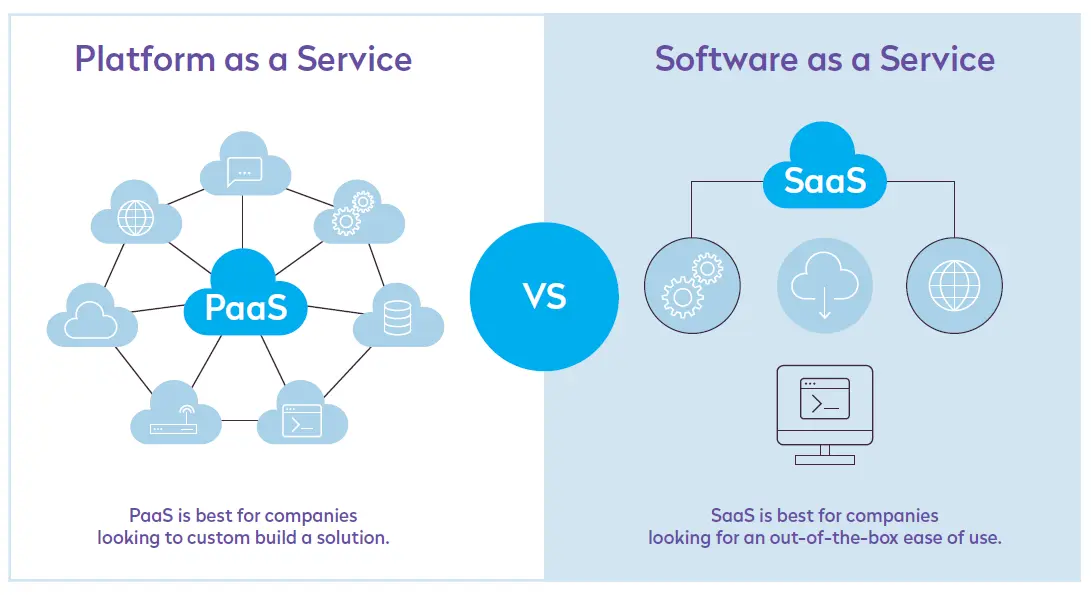Contents
What is Platform-as-a-Service (PaaS)?
In the Platform-as-a-Service (PaaS) model, developers essentially rent everything they need to build an application, relying on a cloud provider for development tools, infrastructure, and operating systems. This is one of the three service models of cloud computing. PaaS vastly simplifies web application development; from the developer's perspective, all backend management takes place behind the scenes. Although PaaS has some similarities with serverless computing, there are many critical differences between them.
What are the three service models of cloud computing?
The three models of cloud computing are PaaS, SaaS (Software-as-a-Service), and IaaS (Infrastructure-as-a-Service). IaaS refers to cloud computing infrastructure – servers, storage, etc. – managed by a cloud vendor, while SaaS refers to full applications that are hosted in the cloud and maintained by the SaaS vendor. If a SaaS customer is like someone renting a house, then a PaaS customer is like someone renting all the heavy equipment and power tools necessary to rapidly build a house, if the tools and equipment were continually maintained and repaired by their owner.
What are PaaS Applications?
The PaaS cloud service model can be applied across a diverse range of business functions, namely those involved in developing and deploying user-friendly applications. Here are some of the main applications that can help businesses and organizations.
Development tools
PaaS vendors provide various tools that are integral to software development. Often, these tools are offered as a framework. However, the specific offerings depend on the provider.
Middleware
Middleware refers to the software that lies between user-facing apps and a machine’s operating system. PaaS vendors provide middleware so that users can perform requests like form submissions on web browsers or allow web servers to return pages based on the user’s profile. It’s essential for running and facilitating the communication of data and information between applications, but end-users don’t interact with it directly.
Operating systems
A PaaS vendor provides and maintains the operating systems that developers and applications work on.
Databases
PaaS vendors administer, manage, and maintain databases for users. This means that providers handle database management functions like upgrades, backups, and monitoring, without involving the user.
Infrastructure
As the next level in the cloud computing model, PaaS includes everything that is involved in IaaS. So a provider will either manage services, storage, and data itself or purchase them from an IaaS vendor.
How does PaaS compare to internally hosted development environments?
PaaS can be accessed over any internet connection, making it possible to build an entire application in a web browser. Because the development environment is not hosted locally, developers can work on the application from anywhere in the world. This enables teams that are spread out across geographic locations to collaborate. It also means developers have less control over the development environment, though this comes with far less overhead.
What is included in PaaS?
The main offerings included by PaaS vendors are:
- Development tools
- Middleware
- Operating systems
- Database management
- Infrastructure
Different vendors may include other services as well, but these are the core PaaS services.
Development tools
PaaS vendors offer a variety of tools that are necessary for software development, including a source code editor, a debugger, a compiler, and other essential tools. These tools may be offered together as a framework. The specific tools offered will depend on the vendor, but PaaS offerings should include everything a developer needs to build their application.
Middleware
Platforms offered as a service usually include middleware, so that developers don't have to build it themselves. Middleware is software that sits in between user-facing applications and the machine's operating system; for example, middleware is what allows software to access input from the keyboard and mouse. Middleware is necessary for running an application, but end users don't interact with it.
Operating systems
A PaaS vendor will provide and maintain the operating system that developers work on and the application runs on.
Databases
PaaS providers administer and maintain databases. They will usually provide developers with a database management system as well.
Infrastructure
PaaS is the next layer up from IaaS in the cloud computing service model, and everything included in IaaS is also included in PaaS. A PaaS provider either manages servers, storage, and physical data centers, or purchases them from an IaaS provider.
Why do developers use PaaS?
Faster time to market
PaaS is used to build applications more quickly than would be possible if developers had to worry about building, configuring, and provisioning their own platforms and backend infrastructure. With PaaS, all they need to do is write the code and test the application, and the vendor handles the rest.
One environment from start to finish
PaaS permits developers to build, test, debug, deploy, host, and update their applications all in the same environment. This enables developers to be sure a web application will function properly as hosted before they release, and it simplifies the application development lifecycle.
Price
PaaS is more cost-effective than leveraging IaaS in many cases. Overhead is reduced because PaaS customers don't need to manage and provision virtual machines. In addition, some providers have a pay-as-you-go pricing structure, in which the vendor only charges for the computing resources used by the application, usually saving customers money. However, each vendor has a slightly different pricing structure, and some platform providers charge a flat fee per month.
Ease of licensing
PaaS providers handle all licensing for operating systems, development tools, and everything else included in their platform.
What are the potential drawbacks of using PaaS?
Vendor lock-in
It may become hard to switch PaaS providers, since the application is built using the vendor's tools and specifically for their platform. Each vendor may have different architecture requirements. Different vendors may not support the same languages, libraries, APIs, architecture, or operating system used to build and run the application. To switch vendors, developers may need to either rebuild or heavily alter their application.
Vendor dependency
The effort and resources involved in changing PaaS vendors may make companies more dependent on their current vendor. A small change in the vendor's internal processes or infrastructure could have a huge impact on the performance of an application designed to run efficiently on the old configuration. Additionally, if the vendor changes their pricing model, an application may suddenly become more expensive to operate.
Security and compliance challenges
In a PaaS architecture, the external vendor will store most or all of an application's data, along with hosting its code. In some cases the vendor may actually store the databases via a further third party, an IaaS provider. Though most PaaS vendors are large companies with strong security in place, this makes it difficult to fully assess and test the security measures protecting the application and its data. In addition, for companies that have to comply with strict data security regulations, verifying the compliance of additional external vendors will add more hurdles to going to market.
How is Platform-as-a-Service different from serverless computing?
PaaS and serverless computing are similar in that for both, all a developer has to worry about is writing and uploading code, and the vendor handles all backend processes. However, scaling is vastly different when using the two models. Applications built using serverless computing, or FaaS, will scale automatically, while PaaS applications will not unless programmed to do so. Startup times also vary greatly; serverless applications can be up and running almost instantly, but PaaS applications are more like traditional applications and have to be running most of the time or all of the time in order to be immediately available for users.
Another difference is that serverless vendors do not provide development tools or frameworks, as PaaS vendors do. And finally, pricing separates the two models. PaaS billing is not nearly as precise as in serverless computing, in which charges are broken down to the number of seconds or fractions of a second each instance of a function runs.
PaaS and Serverless
Both PaaS and serverless platforms enable developers to focus on developing great apps rather than maintaining the hardware and software they need to do so. Although there are many similarities between these two platforms, the key differences are in scalability, pricing, tooling, and whether or not teams can deploy apps at the network edge.
What are the Differences Between IaaS, PaaS, and SaaS?
Now that you’re up to date on all things PaaS, let’s look at how different cloud services stack up against one another.

What is Infrastructure as a Service (IaaS)?
An IaaS platform refers to IT infrastructure hosted in the cloud. It’s made up of virtual servers and provides virtual access to enterprise-grade computing hardware. Key features of IaaS include cloud security, data storage centres, and back-up and analysis.
The most well-known example of an IaaS provider is Amazon Web Services (AWS) which hosts the infrastructure behind web properties such as Airbnb and Netflix. Other examples include Google Computer Engine and Rackspace.
What are the Pros and Cons of IaaS?
Purchasing infrastructure from cloud service platforms like AWS provides companies with cost-effective and robust computing resources that are scalable. The cons of IaaS include the potential of cyber threats, less control born out of the need for outsourcing, and service performance reliability.
What is Software as a Service (SaaS)?
SaaS refers to a cloud-based service where applications are accessed via an internet browser, instead of downloaded and stored on business networks or desktop PCs. With SaaS, everything is managed by third-party providers.
SaaS applications can be office software, unified communications solutions, or numerous other business apps. There’s a diverse range of SaaS technologies for SMBs on the market, some examples include Dropbox, Evernote, Google Workspace, and Cisco WebEx.
What are the Pros and Cons of SaaS?
The main advantages of SaaS include improved accessibility, enhanced compatibility, and operational management. Moreover, SaaS models typically require lower upfront costs than more traditional software solutions which require downloads, installation, and maintenance.
SaaS applications usually require an internet connection to be used. However, some SaaS applications are available offline. Other potential downsides to SaaS applications include vendor lock-in, data security concerns, and lack of control.
It can be confusing to get your head around the differences between the models of cloud. The main decision you’ll need to make when transitioning to the cloud is how much you want to manage yourself (on-site) and how much you want the service provider to manage.
The image below neatly illustrates how IaaS, PaaS, and SaaS compare in terms of who manages what, so you can make the right choice for your business.

Whether classified as IaaS, PaaS, or SaaS, cloud services can yield countless benefits for businesses when it comes to usability and cost-effectiveness.
What are the Types of PaaS?
Different types of cloud PaaS are diverse in how their data is stored and managed. Below is an overview of each.
Public PaaS
A public PaaS service is one that runs on the public cloud. With public PaaS services, the consumer doesn’t need to manage the application stack infrastructure (incl: operating system, database, programming language, etc.)
With public PaaS, users get simplicity and speed to market, but less control over their development stacks. Some small and medium-sized businesses use public PaaS. Most enterprises and large-scale organisations, though, have decided against it due to its connection to the public cloud, which adds security concerns.
Examples include Microsoft Azure, Heroku, and Salesforce.
Private PaaS
With a virtual private cloud PaaS, businesses can enjoy more control over their data. The infrastructure is exclusive to the user and can be stored in a data centre or on-site. The goal of a private PaaS is to deliver the agility of public systems along with the benefits in security and compliance that private data centres provide.
This all sounds great, however, there are some downsides to opting for a private PaaS solution. Here customers have to secure, manage, and maintain physical servers, which is a big price to pay for avoiding the public cloud.
Private PaaS examples include Apprenda, Stackato, and CloudBees.
Hybrid PaaS
Hybrid PaaS is a popular model that a lot of businesses are adopting. The hybrid PaaS model combines public and private to provide greater flexibility of capacity and stability of costs.
An example of a popular hybrid PaaS vendor is Red Hat Openshift.

Communications PaaS
Communications platform-as-a-service (CPaaS) refers to a cloud-based platform that developers can use to add real-time communications features to their app service, without having to build backend interfaces and infrastructures.
By using CPaaS to embed communications features, DevOps teams can save on the costs of human resources, infrastructure, and market time.
RingCentral offers a comprehensive CPaaS solution via the RingCentral developer platform. With this service, teams have access to open-source application programming interfaces (APIS) and embedded communications tech that enables them to add communication platforms like voice, SMS, meetings, and data to business apps for superior customer experience.
Mobile PaaS
Mobile Platform-as-a-service (MPaaS) refers to the development and deployment of mobile apps via the cloud.
OpenPaaS
OpenPaaS is a cloud-based social platform that aims to encourage collaboration and teamwork with a cloud framework. It provides real-time collaboration services like document editing, advanced video conferencing solutions, and business process modelling.
Paas vs Saas

Top Platform as a Service (PaaS) Providers
Some of the top PaaS providers include:
- Amazon AWS: Offers various cloud computing services including computing power, database storage, content delivery, and more. Amazon AWS is one of the biggest players among PaaS vendors.
- Google App Engine: Helps users to build mobile and web back-ends by providing essential programming languages, frameworks, and libraries, while it takes care of infrastructure needs.
- Heroku: PaaS provider that allows users to run apps within containers while taking care of everything else.
- Microsoft Azure: Allows users to deploy apps, services, and infrastructure with access to Azure products related to storage, containers, analytics, Internet of Things (IoT), artificial intelligence (AI), security, etc.
- Oracle Cloud PaaS: Allows users to develop, deploy, and test apps in the cloud.
Key benefits
There are numerous advantages to PaaS that go beyond cutting costs. Let’s take a look at some.
- Reduce coding time: With PaaS development tools, teams can reduce the amount of time spent coding new applications with built-in pre-coded components like workflow, security, search, etc.
- Increased development capabilities: PaaS offerings provide development teams with sophisticated tools and added capabilities, without having to bring on new team members to get the job done.
- Support dispersed or remote teams: Cloud-native computing environments allow remote teams to collaborate and communicate in real-time from different locations.
- Ability to develop for multiple platforms: Certain PaaS service providers provide development options for different platforms like computers, mobile, and web browsers.
- Web application lifecycle support: With PaaS solutions, development teams have access to all the tools they need to effectively build, test within a virtual machine, deploy, and update apps within an integrated environment.
- Cost-effective development: Without having to start from scratch, application development teams that use PaaS can focus on building apps that provide an exceptional user experience. This results in cost savings when it comes to equipment and worker productivity.
Read More:-IaaS – Infrastructure as a Service
SaaS – The Ultimate Guide to Software as a Service
Terraform vs CloudFormation: Comparing The Two Infrastructure As Code Offerings (2022)
IaaS vs. PaaS vs. SaaS: Here’s What You Need to Know About Each

